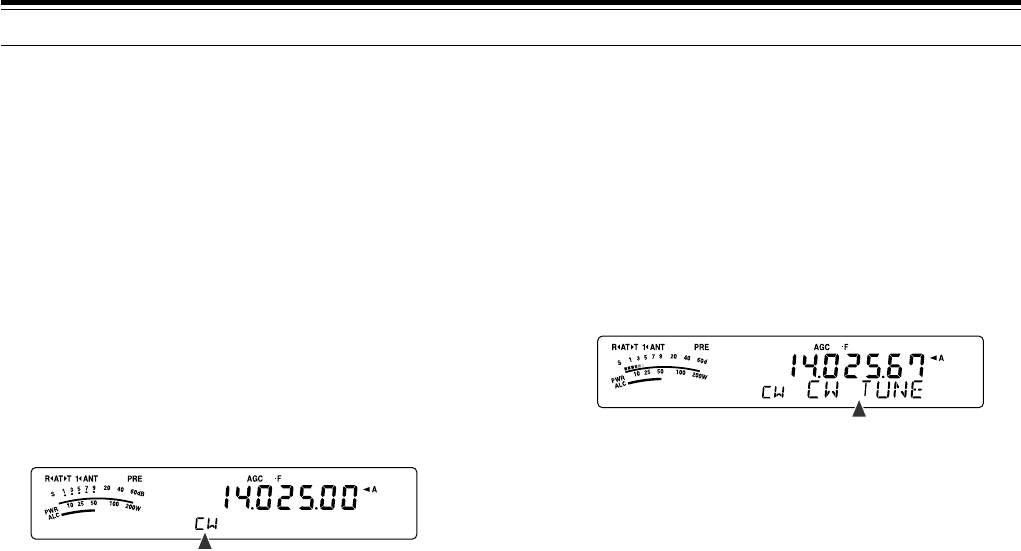
29
6 BASIC COMMUNICATIONS
CW TRANSMISSION
CW operators know that this mode is very reliable
when communicating under worst conditions. It may
be true that newer digital modes rival CW as being
equally as useful in poor conditions. These modes,
however, do not have the long history of service nor
the simplicity that CW provides.
This transceiver has a built-in electronic keyer that
supports a variety of functions. For details on using
these functions, refer to “ELECTRONIC KEYER”
{page 39}.
If necessary, refer to “OPERATING BASICS”,
beginning on page 18, for details on how to receive.
1 Select the operating frequency.
2 Press [MODE] until “CW” or “CWR” appears.
•To precisely tune in another station, use Auto
Zero-beat. Refer to “AUTO ZERO-BEAT”
{below}.
3 Press [VOX/ 8] to activate the CW break-in
function.
• “VOX” appears.
• Refer to “CW BREAK-IN” for further information
on automatic TX/ RX switching {page 39}.
4 Begin sending the message.
• As you transmit, you should hear a sidetone
that lets you monitor your own transmission.
• The LED lights red as you send the message.
5 Stop sending the message to return to Reception
mode.
• The LED lights green or turns off, depending
on the SQL control setting.
AUTO ZERO-BEAT
Use Auto Zero-beat before transmitting to tune in a
CW station. Auto Zero-beat automatically and exactly
matches your transmit frequency with the station you
are receiving. Neglecting to do this will reduce your
chances of being heard by the other station.
1 Tune to the CW signal using the Tuning control.
2 Press [BC/ CW.T] (1 s) to start Auto Zero-beat
while CW is selected for the operating mode.
• “CW TUNE” appears.
•Your reception frequency automatically
changes so that the pitch (tone) of the received
signal exactly matches the TX sidetone/ RX
pitch frequency that you have selected. Refer
to “TX SIDETONE/ RX PITCH FREQUENCY”
{below}.
• When matching is completed, “CW TUNE”
disappears.
• If matching is unsuccessful, the previous
frequency is restored.
3 To quit Auto Zero-beat, press [CLR/ MTR] or
press [BC/ CW.T] again.
Note:
◆
You cannot start Auto Zero-beat if you have selected 1.0 kHz or
wider for the DSP filter bandwidth {page 46}.
◆
When using Auto Zero-beat, the matching error is within
±
50 Hz
in most cases.
◆
Auto Zero-beat may fail if the keying speed of the target station is
too slow or some interference is present.
◆
When the RIT function is ON, only RIT frequencies change to
make the Auto Zero-beat adjustment.
TX SIDETONE/ RX PITCH FREQUENCY
As you send CW, you will hear tones from the
transceiver speaker. These are called TX
(transmission) sidetones. Listening to these tones,
you can monitor what you are transmitting. You may
also use the tones to ensure that your key contacts
are closing, the keyer is functioning, or to practice
sending without actually putting a signal on the air.
RX (reception) pitch refers to the frequency of CW
that you hear after tuning in a CW station.
On this transceiver, the frequency of the sidetone and
RX pitch are equal and selectable. Access Menu No.
34 to select the frequency that is most comfortable for
you. The selectable range is from 400 Hz to 1000 Hz
in steps of 50 Hz (default is 800 Hz).
To change the volume of the TX sidetone, access
Menu No. 13. The selections range from 1 to 9 and
OFF (default is 5).
Note:
The position of the
AF
control does not affect the volume of
the TX sidetone.


















